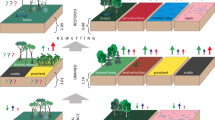Abstract
Rainfall, throughfall, stemflow and spring were studied in a secondary forest during a wet season from April to August in 2006. Some of the chemicals in throughfall, stemflow and spring were increased in contrast with incident rainfall. Specifically, Cl−, HCO3 −, Na+ and Ca2+ were leached negatively in throughfall, but K+ and Mg2+ were leached positively. In stemflow, Cl− and Na+ were leached negatively, the others were leached positively and their concentrations were higher than those in throughfall. Total carbon, organic carbon and inorganic carbon in throughfall and stemflow were increased as rainfall went through the secondary forest. The concentration of free CO2 in rainfall was lower than both, throughfall and stemflow; the relationship between total acidity and free CO2 was linear. pH of throughfall and stemflow , such as maximum, minimum and mean, were lower than that of rainfall and the extent of pH in spring was changed minimally. We came to a conclusion that rainfall via the secondary forest can lead to further erosion, accelerate the biogeochemical cycle in epikarst zone, enhance the effective state of alkali elements in the soil, supply vegetation with more nutrients and advance vegetation’s growth and succession, which are reasonably sufficient to form a stable karst ecosystem.




Similar content being viewed by others
References
Cao JH, Yuan DX, Pei JG et al (2005) Karst ecosystem of southwest China constrained by geological setting. In: Summary, vol 1. Geology Press, Beijing, pp 1–8
Chen SJ, Tian DL, Kang WX, Yan WD (2004) Chemical properties of precipitation in the artificial forest of Cinnamomum camphora (L.) Pres. J Cent South For Univ 24:6–10
Chen YR, Lin YM, Li JY, Liu YF, Yang NR (2000) Rainfall process and nutrient dynamics of artificial Chinese fir plantation in Jiangxi Qianyanzhou experimental station. Chin J Eco-Agri 12:74–76
Jiang ZC (1997) Doloston element of Karst geo-chemical migration in Guangxi Nongla. Carsologica Sin 16:304–312
Jiang ZC, Yuan DX (1999) Karst dynamical characteristics and significance of environment and resources in epikarst zone. ACTA Geosci Sin 20:302–307
Likens GE, Eaton JS (1970) A polyurethane stemflow collector for trees and shrubs. Ecology 51:938–939
Luo Y, Zhou GY, Zhang DQ, Guan LL, Ouyang XJ, Zhu GW (2004) Study on the concentration of total organic carbon in the forest hydrological processes of three main forest types in Dinghushan during a rain season. ACTA Ecol Sin 24:2973–2978
Nelda D, Noemi C (2006) Nutrient fluxes in incident rainfall, throughfall, and stemflow in adjacent primary and secondary forests of the Gran Sabana, southern Venezuela. For Ecol Manage 234:218–226
Pan HB, Ma Z, Liang YC (1996) Chemical properties of open and intercepted precipitation in Chinese fir plantation in Nanping, Chian. J Fujian Coll For 16:101–104
Ran JC, He SY, Cao JH, Xiong ZB, Chen HM (2002) Researchs on effects of water and soil conservation of subtropic karst forest. J Water Soil Conserv 16:92–95
Roberto G, Carlos O, Victor G (2001) Precipitation chemistry in deciduous and evergreen Nothofagus forests of southern Chile under a low-deposition climate. Basic Appl Ecol 2:65–72
Tian DL, Xiang WH, Yang WH (2002) Nutrient characteristics of hydrological process in Young Second-rotation Chinese fir plantations. ACTA Ecol Sin 22:859–865
Yawney HW, Leaf AL (1970) The contribution of throughfall and stemflow to nutrient element cycling in red pine plantations. Agron (Abstract 164)
Yu XJ, Wang SL, Deng SJ, Zhang YX (2003) Nutrient characteristics of stemflow and throughfall in evergreen broad-leaved forest and Cunninghamia lanceolata plantation forest. Chin J Ecol 22:7–11
Yuan DX (1997) Sensitivity of karst process to environmental change along the PEP II transect. Quaternary 37:105–113
Zhang C, Yuan DX, Cao JH (2004) An analysis of short-term scale variation of the typical epikarst spring. ACTA Geosci Sin 25:467–471
Zhou GY, Luo Y, Ouyang XJ, Zhu GW, Zhang QM (2003) Analysis on the concentration of some sediment elements in their transport process through monsoon evergreen broad-leaved forest ecosystem in Dinghushan, Guangdong Province, China. ACTA Ecol Sin 23:1408–1413
Author information
Authors and Affiliations
Corresponding author
Rights and permissions
About this article
Cite this article
Deng, X., Jiang, Z. Hydrogeochemical effects of secondary forest in Guangxi Nongla karst areas in China. Environ Geol 56, 921–926 (2009). https://doi.org/10.1007/s00254-008-1193-4
Received:
Accepted:
Published:
Issue Date:
DOI: https://doi.org/10.1007/s00254-008-1193-4




